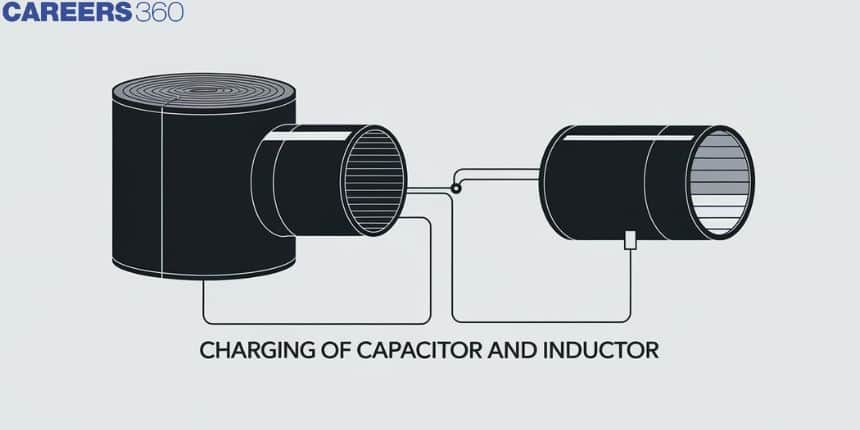Charging of capacitor and inductor
The charging of capacitors and inductors plays a crucial role in understanding the behaviour of electrical circuits, particularly in energy storage and conversion. A capacitor stores energy in an electric field, while an inductor stores energy in a magnetic field. These components are essential in devices like cameras, where a capacitor helps store energy for the flash, or in power supplies, where inductors smooth out voltage variations. In real life, charging a capacitor is similar to filling a water tank—initially fast, but slowing down as it nears full capacity. Similarly, charging an inductor involves building up a magnetic field gradually, much like winding up a spring. These principles are fundamental to various applications, from smartphones to electric vehicles, showcasing their significance in modern technology.
JEE Main/NEET 2027: Physics Important Formulas for Class 10
NEET 2025: Mock Test Series | Syllabus | High Scoring Topics | PYQs
JEE Main: Study Materials | High Scoring Topics | Preparation Guide
JEE Main: Syllabus | Sample Papers | Mock Tests | PYQs
- Charging of a Capacitor
- Discharging of Capacitors
- Charging and Discharging of an Inductor
- Solved Examples Based on Charging of capacitor and inductor
- Summary

Charging of a Capacitor
When a capacitor with zero charges is connected to a battery of emf V through connecting wires, the total resistance including internal resistance of the battery and of the connecting wires is R then after a time t let the charge on the capacitor be q, current be i and
charge deposited on the positive plate in time
Using Kirchhoffs loop law,
or,
or,
or,
or,
or,
or,
Where RC is the time constant
At
Discharging of Capacitors
If initially a capacitor has a charge Q and is discharged through an external load. Let after a time t the remaining charge in the capacitor be q then
Using Kirchhoff's loop law,
Here
Thus,
or,
or,
or,
or,

Note: A steady-state capacitor connected to the DC battery acts as an open circuit. The capacitor does not allow a sudden change in voltage.
Charging and Discharging of an Inductor
When an inductor is connected to a DC source of emf v through a resistance R the inductor charges to maximum current
While the discharging of inductor current decreases exponentially and is given by

Note: At steady state, an inductor connected to the DC battery acts as a short circuit. The inductor does not allow a sudden change in current.
Recommended Topic Video
Solved Examples Based on Charging of capacitor and inductor
Example 1: Two identical capacitors A and B, charged to the same potential 5 V are connected in two different circuits as shown below at time
1)
2)
3)
4)
Solution:
Maximum charge on the capacitor
(a) is reverse-biased and (b) is forward-biased
(a) (b)
So,
Hence the correct option is (4).
Example 2:

As shown in the figure, a battery of emf
1)
2)
3)
4)
Solution:
As current at any time
So integrating this will give a total charge
Hence the correct option is (4).
Example 3 : The current (i) at time
1)
2)
3)
4)
Solution:
At t = 0, the inductor is open
So the corresponding equivalent circuit is given below

At
So the corresponding equivalent circuit is given below

We can reduce the above circuit to the below circuit.

Hence the correct option is (1).
Example 4: Figure shows a circuit that contains four identical resistors with resistance
1) 9 A
2) 2.25 A
3) 3.0 A
4) 3.37 A
Solution:
Just when switch S is closed, the inductor will behave like an infinite resistance. Hence, the circuit will be like

Given:
From
Req.
Hence the correct option is (2).
Example 5: In the following figure, the charge (in

1) 12
2) 6
3) 9
4) 3
Solution:
Charging Of Capacitors
wherein
In the R-C circuit (Transient State).
.The potential difference across 4 W resistance is
In steady-state current flows through 4-ohm resistance only and it is Hence, the potential difference across each capacitor is 4 V
So charge on each capacitor
Summary
The charging and discharging of capacitors and inductors follow exponential processes that are essential in various circuits. A capacitor charges by storing energy in an electric field and discharges through a gradual release of this energy, while an inductor stores energy in a magnetic field and behaves similarly in its charging and discharging process. The time constant, denoted as RC for capacitors and L/R for inductors, determines the rate of these processes. These principles are critical in many real-world applications, from power supplies to electronic devices.
Also Read
26 Sep'24 11:02 AM



